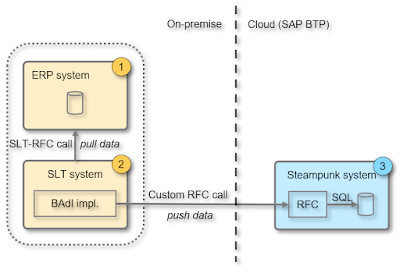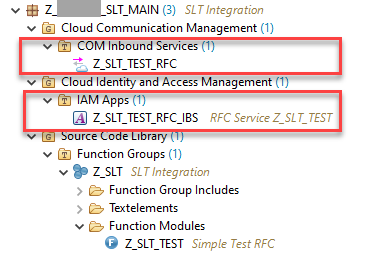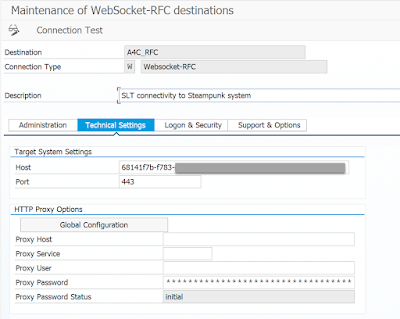This approach is supported with the current Steampunk release and can be used immediately.
◉ There are custom SLT installations with > 30 millions transferred data changes per hour (numbers with Steampunk setup not yet available / to be tested)
◉ Replication into Steampunk (application-level) instead of HANA Cloud (DB-level, below Steampunk) avoids lifecycle issues with DDIC tables and is nicely integrated into the existing Steampunk application Identity and Access Management (IAM) concepts
◉ Only custom tables are supported on target side (Steampunk), but no SAP-delivered tables
4. Activate the function group and the function module. As a result, a COM inbound service and a IAM app is automatically generated as you can see in the ADT Project Explorer.
5. Create a communication scenario Z_SLT, assign the COM Inbound Service Z_SLT_TEST_RFC and set only Basic as Supported Authentication Method.
In the Logon & Security tab, select Explicit Client by Hostname and Authentication Method by User/Password with Alias User and enter the user name and the password of the communication user created in the app Communication Systems.
Save the connection and press the button Connection Test. Correct the settings in case of connection errors.
Call the test RFC in SLT system
Create local report ZSLT_TEST_RFC in the SLT system to test the RFC call:
REPORT zslt_test_rfc.
DATA lv_test TYPE string.
CALL FUNCTION 'Z_SLT_TEST' DESTINATION 'A4C_RFC'
IMPORTING
test = lv_test
EXCEPTIONS
OTHERS = 1.
IF sy-subrc = 0.
WRITE: / lv_test.
ELSE.
WRITE: / 'Error occurred'.
ENDIF.
Activate and execute the local report. The RFC implemented in the Steampunk system is called and the expected output is 42.
Setup of SLT: Database Table
In our example, we use the following simple custom table defined in the source system. The described SLT approach requires, that the custom table is created manually in the Steampunk system as well. It is recommended to use the same structure definition in the Steampunk system like in the source system. For that purpose, the technical settings (direct typing) are sufficient – there is no need to create all domains and data elements in the Steampunk system.
Create the following custom table ZSLT_TEST in the source system and in the Steampunk system with the following structure:
@EndUserText.label : 'SLT Data Replication Test'
@AbapCatalog.enhancement.category : #NOT_EXTENSIBLE
@AbapCatalog.tableCategory : #TRANSPARENT
@AbapCatalog.deliveryClass : #A
@AbapCatalog.dataMaintenance : #RESTRICTED
define table zslt_test {
key client : abap.clnt not null;
key uuid : abap.raw(16) not null;
name : abap.char(10);
description : abap.char(100);
}
Create a local report ZSLT_TEST_FILL_DATA in the source system to fill test data into our test custom table:
REPORT zslt_test_fill_data.
PARAMETERS p_count TYPE i DEFAULT 10.
PARAMETERS p_delete AS CHECKBOX.
START-OF-SELECTION.
PERFORM main.
FORM main.
IF p_delete = abap_true.
DELETE FROM zslt_test.
COMMIT WORK.
ENDIF.
DATA lt_slt_test TYPE STANDARD TABLE OF zslt_test WITH EMPTY KEY.
DO p_count TIMES.
DATA(lv_index) = sy-index.
TRY.
APPEND VALUE #(
uuid = cl_system_uuid=>create_uuid_x16_static( )
name = |{ lv_index NUMBER = USER }|
description = |{ sy-datlo DATE = USER } { sy-timlo TIME = USER }|
) TO lt_slt_test.
CATCH cx_uuid_error.
ASSERT 1 = 2.
ENDTRY.
ENDDO.
INSERT zslt_test FROM TABLE lt_slt_test.
COMMIT WORK.
ENDFORM.
Activate and execute the local report with default settings to create 10 records in custom table ZSLT_TEST.
Setup of SLT: Configuration
Use transaction LTRC to create a new SLT configuration. The important setting for Steampunk is in step Specify Target System: Select Connection Details = Other and Scenario = SLT SDK.
For more information about other settings please refer to the SLT documentation below.
Implement the SLT SDK Business Add-In
Create an implementation for enhancement spot ES_IUUC_REPL_RUNTIME_OLO_EXIT. Create a BAdI implementation for BADI_IUUC_REPL_OLO_EXIT based on interface IF_BADI_IUUC_REPL_OLO_EXIT. Only two of the four interface methods are relevant:
◉ IF_BADI_IUUC_REPL_OLO_EXIT~WRITE_DATA_FOR_INITIAL_LOAD
◉ IF_BADI_IUUC_REPL_OLO_EXIT~WRITE_DATA_FOR_REPL
Create an empty implementation for the other two interface methods.
A generic implementation for the initial load any custom database tables might look like:
METHOD if_badi_iuuc_repl_olo_exit~write_data_for_initial_load.
CLEAR ev_error_code.
CLEAR et_return.
"push initial load
TYPES BEGIN OF ty_ls_table_w_payload_il.
TYPES tabname_source TYPE c LENGTH 30.
TYPES payload TYPE xstring.
TYPES END OF ty_ls_table_w_payload_il.
TYPES ty_lt_table_w_payload_il TYPE STANDARD TABLE OF ty_ls_table_w_payload_il
WITH DEFAULT KEY .
DATA lt_table_w_payload_il TYPE ty_lt_table_w_payload_il.
DATA lv_dbtab_xml TYPE xstring.
FIELD-SYMBOLS <lt_dbtab_data> TYPE STANDARD TABLE.
LOOP AT it_table_w_content ASSIGNING FIELD-SYMBOL(<ls_table_w_content>).
ASSIGN <ls_table_w_content>-payload->* TO <lt_dbtab_data>.
TRY.
"serialize table data to xml or json
IF 1 = 2.
"xml
CALL TRANSFORMATION id
SOURCE root = <lt_dbtab_data>
RESULT XML lv_dbtab_xml.
ELSE.
"json
DATA(lo_xml_writer) = cl_sxml_string_writer=>create( type = if_sxml=>co_xt_json ).
CALL TRANSFORMATION id
SOURCE root = <lt_dbtab_data>
RESULT XML lo_xml_writer.
lv_dbtab_xml = lo_xml_writer->get_output( ).
FREE lo_xml_writer.
ENDIF.
CATCH cx_root INTO DATA(lx_root) ##catch_all.
ev_error_code = 1.
APPEND VALUE #( type = 'E' message = lx_root->get_text( ) ) TO et_return.
RETURN.
ENDTRY.
APPEND VALUE #( tabname_source = <ls_table_w_content>-tabname_source
payload = lv_dbtab_xml ) TO lt_table_w_payload_il.
FREE lv_dbtab_xml.
ENDLOOP.
DATA lv_payload_xml TYPE xstring.
CALL TRANSFORMATION id
SOURCE root = lt_table_w_payload_il
RESULT XML lv_payload_xml.
FREE lt_table_w_payload_il.
CALL FUNCTION 'Z_SLT_WRITE_DATA_INITIAL_LOAD' DESTINATION 'A4C_RFC'
EXPORTING
iv_payload = lv_payload_xml
IMPORTING
ev_error_code = ev_error_code
et_return = et_return
EXCEPTIONS
OTHERS = 1.
IF sy-subrc <> 0.
ev_error_code = sy-subrc.
APPEND VALUE #( type = 'E' message = 'RFC error occurred' ) TO et_return ##NO_TEXT.
RETURN.
ENDIF.
ENDMETHOD.
A generic implementation for the delta load any custom database tables might look like:
METHOD if_badi_iuuc_repl_olo_exit~write_data_for_repl.
CLEAR ev_error_code.
CLEAR et_return.
"push delta load
TYPES BEGIN OF ty_ls_table_w_payload.
TYPES operation TYPE c LENGTH 1.
TYPES tabname_source TYPE c LENGTH 30.
TYPES payload TYPE xstring.
TYPES END OF ty_ls_table_w_payload.
TYPES ty_lt_table_w_payload TYPE STANDARD TABLE OF ty_ls_table_w_payload
WITH DEFAULT KEY .
DATA lt_table_w_payload TYPE ty_lt_table_w_payload.
DATA lv_dbtab_xml TYPE xstring.
FIELD-SYMBOLS <lt_dbtab_data> TYPE STANDARD TABLE.
LOOP AT it_table_w_content ASSIGNING FIELD-SYMBOL(<ls_table_w_content>).
ASSIGN <ls_table_w_content>-payload->* TO <lt_dbtab_data>.
TRY.
"serialize table data to xml or json
IF 1 = 2.
"xml
CALL TRANSFORMATION id
SOURCE root = <lt_dbtab_data>
RESULT XML lv_dbtab_xml.
ELSE.
"json
DATA(lo_xml_writer) = cl_sxml_string_writer=>create( type = if_sxml=>co_xt_json ).
CALL TRANSFORMATION id
SOURCE root = <lt_dbtab_data>
RESULT XML lo_xml_writer.
lv_dbtab_xml = lo_xml_writer->get_output( ).
FREE lo_xml_writer.
ENDIF.
CATCH cx_root INTO DATA(lx_root) ##catch_all.
ev_error_code = 1.
APPEND VALUE #( type = 'E' message = lx_root->get_text( ) ) TO et_return.
RETURN.
ENDTRY.
APPEND VALUE #( operation = <ls_table_w_content>-operation
tabname_source = <ls_table_w_content>-tabname_source
payload = lv_dbtab_xml ) TO lt_table_w_payload.
FREE lv_dbtab_xml.
ENDLOOP.
DATA lv_payload_xml TYPE xstring.
CALL TRANSFORMATION id
SOURCE root = lt_table_w_payload
RESULT XML lv_payload_xml.
FREE lt_table_w_payload.
CALL FUNCTION 'Z_SLT_WRITE_DATA_DELTA_LOAD' DESTINATION 'A4C_RFC'
EXPORTING
iv_payload = lv_payload_xml
IMPORTING
ev_error_code = ev_error_code
et_return = et_return
EXCEPTIONS
OTHERS = 1.
IF sy-subrc <> 0.
ev_error_code = sy-subrc.
APPEND VALUE #( type = 'E' message = 'RFC error occurred' ) TO et_return ##NO_TEXT.
RETURN.
ENDIF.
ENDMETHOD.
Both methods are referring to the RFC modules implemented in the Steampunk system (see next section) and the RFC destination A4C_RFC.
Implement the Steampunk SLT Inbound RFC
Create new RFC-enabled function modules in function group Z_SLT:
◉ Z_SLT_WRITE_DATA_INITIAL_LOAD for the initial load implementation
◉ Z_SLT_WRITE_DATA_DELTA_LOAD for the delta load implementation
Activate both RFC-enabled function modules which creates two COM inbound services and two IAM apps automatically. Add the two COM inbound services to the custom communication scenario Z_SLT and save. Press Publish Locally for the communication scenario Z_SLT.
An example implementation for Z_SLT_WRITE_DATA_INITIAL_LOAD is:
FUNCTION z_slt_write_data_initial_load
IMPORTING
VALUE(iv_payload) TYPE xstring
EXPORTING
VALUE(ev_error_code) TYPE i
VALUE(et_return) TYPE bapirettab.
"get initial load
TYPES BEGIN OF ty_ls_table_w_payload_il.
TYPES tabname_source TYPE c LENGTH 30.
TYPES payload TYPE xstring.
TYPES END OF ty_ls_table_w_payload_il.
TYPES ty_lt_table_w_payload_il TYPE STANDARD TABLE OF ty_ls_table_w_payload_il
WITH DEFAULT KEY .
DATA lt_table_w_payload_il TYPE ty_lt_table_w_payload_il.
TRY.
CALL TRANSFORMATION id
SOURCE XML iv_payload
RESULT root = lt_table_w_payload_il.
FREE iv_payload.
DATA lr_dbtab_data TYPE REF TO data.
LOOP AT lt_table_w_payload_il ASSIGNING FIELD-SYMBOL(<ls_table_w_payload_il>).
CREATE DATA lr_dbtab_data TYPE STANDARD TABLE OF (<ls_table_w_payload_il>-tabname_source) WITH EMPTY KEY.
CALL TRANSFORMATION id
SOURCE XML <ls_table_w_payload_il>-payload
RESULT root = lr_dbtab_data->*.
FREE <ls_table_w_payload_il>-payload.
INSERT (<ls_table_w_payload_il>-tabname_source) FROM TABLE @lr_dbtab_data->*.
COMMIT WORK.
FREE lr_dbtab_data.
ENDLOOP.
CATCH cx_root INTO DATA(lx_root) ##catch_all.
ev_error_code = 1.
APPEND VALUE #( type = 'E' message = lx_root->get_text( ) ) TO et_return.
RETURN.
ENDTRY.
ENDFUNCTION.
An example implementation for Z_SLT_WRITE_DATA_DELTA_LOAD is:
FUNCTION z_slt_write_data_delta_load
IMPORTING
VALUE(iv_payload) TYPE xstring
EXPORTING
VALUE(ev_error_code) TYPE i
VALUE(et_return) TYPE bapirettab.
"get initial load
TYPES BEGIN OF ty_ls_table_w_payload.
TYPES operation TYPE c LENGTH 1.
TYPES tabname_source TYPE c LENGTH 30.
TYPES payload TYPE xstring.
TYPES END OF ty_ls_table_w_payload.
TYPES ty_lt_table_w_payload TYPE STANDARD TABLE OF ty_ls_table_w_payload
WITH DEFAULT KEY .
DATA lt_table_w_payload TYPE ty_lt_table_w_payload.
TRY.
CALL TRANSFORMATION id
SOURCE XML iv_payload
RESULT root = lt_table_w_payload.
FREE iv_payload.
DATA lr_dbtab_data TYPE REF TO data.
LOOP AT lt_table_w_payload ASSIGNING FIELD-SYMBOL(<ls_table_w_payload>).
CREATE DATA lr_dbtab_data TYPE STANDARD TABLE OF (<ls_table_w_payload>-tabname_source) WITH EMPTY KEY.
CALL TRANSFORMATION id
SOURCE XML <ls_table_w_payload>-payload
RESULT root = lr_dbtab_data->*.
FREE <ls_table_w_payload>-payload.
CASE <ls_table_w_payload>-operation.
WHEN 'I'.
INSERT (<ls_table_w_payload>-tabname_source) FROM TABLE @lr_dbtab_data->*.
COMMIT WORK.
WHEN 'D'.
DELETE (<ls_table_w_payload>-tabname_source) FROM TABLE @lr_dbtab_data->*.
COMMIT WORK.
WHEN 'U'.
UPDATE (<ls_table_w_payload>-tabname_source) FROM TABLE @lr_dbtab_data->*.
COMMIT WORK.
ENDCASE.
FREE lr_dbtab_data.
ENDLOOP.
CATCH cx_root INTO DATA(lx_root) ##catch_all.
ev_error_code = 1.
APPEND VALUE #( type = 'E' message = lx_root->get_text( ) ) TO et_return.
RETURN.
ENDTRY.
ENDFUNCTION.
Test the SLT Replication
Start transaction LTRC and navigate to the created SLT configuration. Click on Data Provisioning, add the table name ZSLT_TEST and select Start Replication which incudes Start Load automatically.
Take a look into the SLT logs and check, whether the initially created 10 entries are transferred into the Steampunk system.
Use the local report ZSLT_TEST_FILL_DATA to delete the existing 10 entries and to create 5 new records in table ZSLT_TEST. Please verify manually, that these changes in the source system are immediately reflected in the Steampunk system.
Source: sap.com






No comments:
Post a Comment